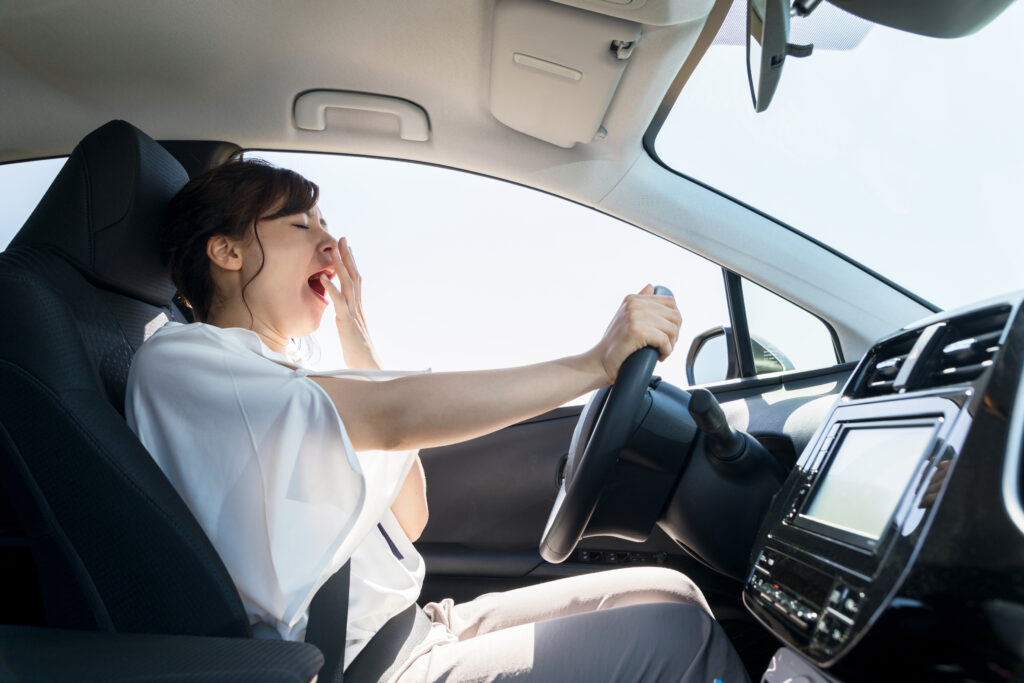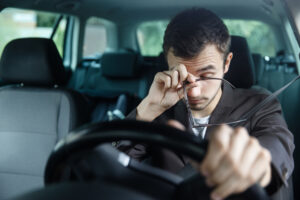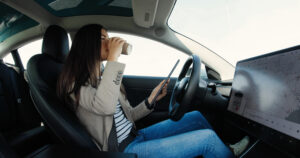Which Drivers Have a High Risk of Drowsiness
cartwrightlaw - March 6, 2023 -

Driving while fatigued, drowsy driving, sleepy driving – all of these are terms used to refer to the act of driving when you ought to be sleeping. Whatever you choose to call it, drowsy driving is every bit as dangerous as driving under the influence and has many of the same effects. If you or a loved one have suffered an injury in a drowsy driving accident, you need to contact an experienced car accident attorney for an initial consultation right away.
Drowsy driving is, in many ways, strikingly similar to drunk driving and is usually considered virtually as dangerous. Both conditions slow the driver’s reaction times and affect alertness and the ability to make decisions. Fatigue does not create the impulsive, uninhibited behavior of the drunk driver, but it affects the driver’s ability to be aware, vigilant, and timely in response to danger.
After about 18 hours of being awake, reaction time, multi-tasking, vigilance, and hand-eye coordination are similar to those of a driver with a blood alcohol content level of 0.05 percent. After 20 hours, the impairment mirrors a 0.08 percent BAC, the level at which one is considered a drunk driver in most states. After 24 hours, it reaches the hazardous 0.1 percent level. All of the equivalencies make a drowsy driver as significant a threat as a drunk driver.
Drowsy Driving Stats
According to the NHTSA, three facts are common to many drowsy driver accidents:
- They usually occur between midnight and 6 a.m. or in the late afternoon. These periods are typical times for a drop in energy and alertness during the circadian rhythm cycle. In other words, you are genetically programmed to be sleepy during these periods.

- They are often single-vehicle accidents involving a driver who goes off the road at high speed with no signs of attempts to stop. This is especially common when there are no passengers to notice the driver fell asleep and take action.
- They frequently happen on rural highways and roads.
Typical Drowsy Driver
Certain groups of drivers are more likely than others to drive while sleepy. These drivers include the following:
- Drivers on the road between midnight and 6 a.m. or late afternoon. Our circadian rhythm causes dips in energy and alertness at these times, making these drivers more vulnerable.
- Teens and young adults. These young adults generally need more sleep than adults under any circumstances. It doesn’t stop them from driving.
- At the risk of sounding silly, drivers who don’t get enough sleep often drive while sleepy. We live in a culture whose demands lead many of us to get too little sleep and still need to drive, a dangerous combination.
- Professional truck drivers – Big-rig truck drivers are under tremendous time pressure, particularly when perishable goods are involved. Federal and state rules govern hours of driving and rest for professional drivers, but they often get ignored. The most common violations involve exceeding on-duty limits and driving more than 60 hours in 7 days.
- Night shift workers are at risk because of the same circadian rhythm issues mentioned above. It is challenging, if possible at all, to revise one’s circadian rhythm. Late-shift workers will thus always be at risk of drowsy driving.
- Finally, drivers with unknown or untreated sleep disorders will drive sleepy because they are always sleepy.
- Drivers using drugs, alcohol, or medications can experience drowsiness as a side effect. While drinking and driving are already illegal and using illegal drugs is by definition against the law, even the use of over-the-counter or prescription medications can cause drowsy driving. There’s a reason for the “don’t operate heavy machinery” warning on so many medications – it’s dangerous to drive while on Nyquil or Norcan!
Ways to Avoid Drowsy Driving
As we’ve seen, driving while sleeping is just as dangerous as driving while drunk and should be avoided at all costs. Some suggestions for doing so are below.
- Get enough sleep. This is easier said than done in today’s sleep-deprived America, but experts say you should get at least 7 hours a night.
- Before a planned long journey, don’t aim for more sleep – make sure you get a good night’s sleep, or you may put yourself and your passengers at high risk of injury or death.
- Make sure your teenagers are getting adequate sleep if they drive. Even if they don’t drive, it’s far better for their health and academic performance to make sure they get enough sleep.
- Don’t drink and drive, especially if you’re already tired or sleepy. Together, they create severe impairment.

- Read the labels on your medications before you drive. Many drugs, including cold remedies and pain control medications, can cause severe drowsiness. Make sure you should be driving given what you’re taking. If you have to get somewhere and have to take medications, consider some form of public transportation or ride-share.
- Avoid driving between 6 and midnight or during late afternoons if you can. If you must drive during these peak drowsiness periods, keep a lookout for signs of fatigue, such as struggling to stay in your lane or frequent rumble strip visits.
- Coffee and energy drinks may help, but only for the short term. Not only that, but they can also make you overconfident regarding your alertness and ability to drive. Even with coffee, you can fall asleep for four or five seconds, long enough to cause an accident, especially at higher speeds.
- Drink some coffee and pull off for a brief nap in a safe space like a rest stop. This technique can increase your alertness for a short period.
Contact a Bay Area Car Accident Lawyer Today
If you or a loved one suffered an injury due to a drowsy driver, contact one of our experienced car accident attorneys today. We can help you with your financial and physical recovery while you focus on your emotional and psychological recovery. There’s no cost to your initial consultation and case evaluation, so don’t waste time getting help with your case immediately.
Driving while fatigued, drowsy driving, sleepy driving – all of these are terms used to refer to the act of driving when you ought to be sleeping. Whatever you choose to call it, drowsy driving is every bit as dangerous as driving under the influence and has many of the same effects. If you or a loved one have suffered an injury in a drowsy driving accident, you need to contact an experienced car accident attorney for an initial consultation right away.
Drowsy driving is, in many ways, strikingly similar to drunk driving and is usually considered virtually as dangerous. Both conditions slow the driver’s reaction times and affect alertness and the ability to make decisions. Fatigue does not create the impulsive, uninhibited behavior of the drunk driver, but it affects the driver’s ability to be aware, vigilant, and timely in response to danger.
After about 18 hours of being awake, reaction time, multi-tasking, vigilance, and hand-eye coordination are similar to those of a driver with a blood alcohol content level of 0.05 percent. After 20 hours, the impairment mirrors a 0.08 percent BAC, the level at which one is considered a drunk driver in most states. After 24 hours, it reaches the hazardous 0.1 percent level. All of the equivalencies make a drowsy driver as significant a threat as a drunk driver.
Drowsy Driving Stats
According to the NHTSA, three facts are common to many drowsy driver accidents:
- They usually occur between midnight and 6 a.m. or in the late afternoon. These periods are typical times for a drop in energy and alertness during the circadian rhythm cycle. In other words, you are genetically programmed to be sleepy during these periods.

- They are often single-vehicle accidents involving a driver who goes off the road at high speed with no signs of attempts to stop. This is especially common when there are no passengers to notice the driver fell asleep and take action.
- They frequently happen on rural highways and roads.
Typical Drowsy Driver
Certain groups of drivers are more likely than others to drive while sleepy. These drivers include the following:
- Drivers on the road between midnight and 6 a.m. or late afternoon. Our circadian rhythm causes dips in energy and alertness at these times, making these drivers more vulnerable.
- Teens and young adults. These young adults generally need more sleep than adults under any circumstances. It doesn’t stop them from driving.
- At the risk of sounding silly, drivers who don’t get enough sleep often drive while sleepy. We live in a culture whose demands lead many of us to get too little sleep and still need to drive, a dangerous combination.
- Professional truck drivers – Big-rig truck drivers are under tremendous time pressure, particularly when perishable goods are involved. Federal and state rules govern hours of driving and rest for professional drivers, but they often get ignored. The most common violations involve exceeding on-duty limits and driving more than 60 hours in 7 days.
- Night shift workers are at risk because of the same circadian rhythm issues mentioned above. It is challenging, if possible at all, to revise one’s circadian rhythm. Late-shift workers will thus always be at risk of drowsy driving.
- Finally, drivers with unknown or untreated sleep disorders will drive sleepy because they are always sleepy.
- Drivers using drugs, alcohol, or medications can experience drowsiness as a side effect. While drinking and driving are already illegal and using illegal drugs is by definition against the law, even the use of over-the-counter or prescription medications can cause drowsy driving. There’s a reason for the “don’t operate heavy machinery” warning on so many medications – it’s dangerous to drive while on Nyquil or Norcan!
Ways to Avoid Drowsy Driving
As we’ve seen, driving while sleeping is just as dangerous as driving while drunk and should be avoided at all costs. Some suggestions for doing so are below.
- Get enough sleep. This is easier said than done in today’s sleep-deprived America, but experts say you should get at least 7 hours a night.
- Before a planned long journey, don’t aim for more sleep – make sure you get a good night’s sleep, or you may put yourself and your passengers at high risk of injury or death.
- Make sure your teenagers are getting adequate sleep if they drive. Even if they don’t drive, it’s far better for their health and academic performance to make sure they get enough sleep.
- Don’t drink and drive, especially if you’re already tired or sleepy. Together, they create severe impairment.

- Read the labels on your medications before you drive. Many drugs, including cold remedies and pain control medications, can cause severe drowsiness. Make sure you should be driving given what you’re taking. If you have to get somewhere and have to take medications, consider some form of public transportation or ride-share.
- Avoid driving between 6 and midnight or during late afternoons if you can. If you must drive during these peak drowsiness periods, keep a lookout for signs of fatigue, such as struggling to stay in your lane or frequent rumble strip visits.
- Coffee and energy drinks may help, but only for the short term. Not only that, but they can also make you overconfident regarding your alertness and ability to drive. Even with coffee, you can fall asleep for four or five seconds, long enough to cause an accident, especially at higher speeds.
- Drink some coffee and pull off for a brief nap in a safe space like a rest stop. This technique can increase your alertness for a short period.
Contact a Bay Area Car Accident Lawyer Today
If you or a loved one suffered an injury due to a drowsy driver, contact one of our experienced car accident attorneys today. We can help you with your financial and physical recovery while you focus on your emotional and psychological recovery. There’s no cost to your initial consultation and case evaluation, so don’t waste time getting help with your case immediately.
“Our successful case results are a reflection of the values and virtues we believe in and uphold at Cartwright Law Firm. Nothing stops us from pursuing justice on behalf of those who need it.
Robert E. Cartwright Jr.
Founder and Managing Partner

